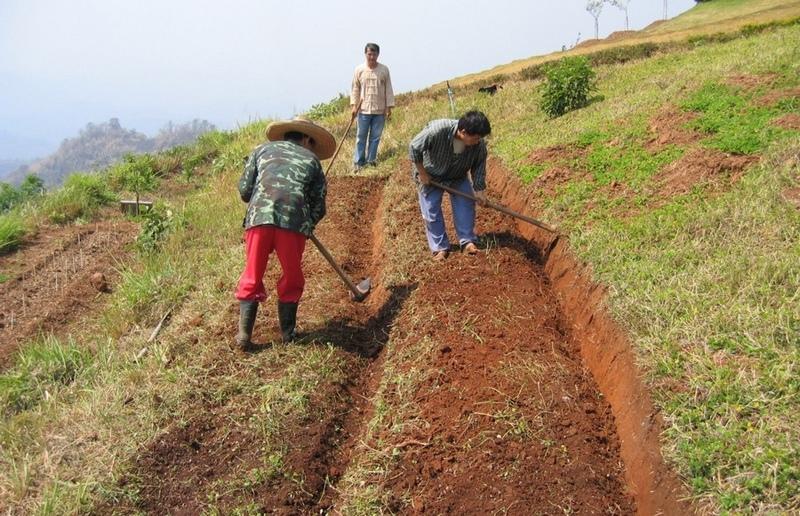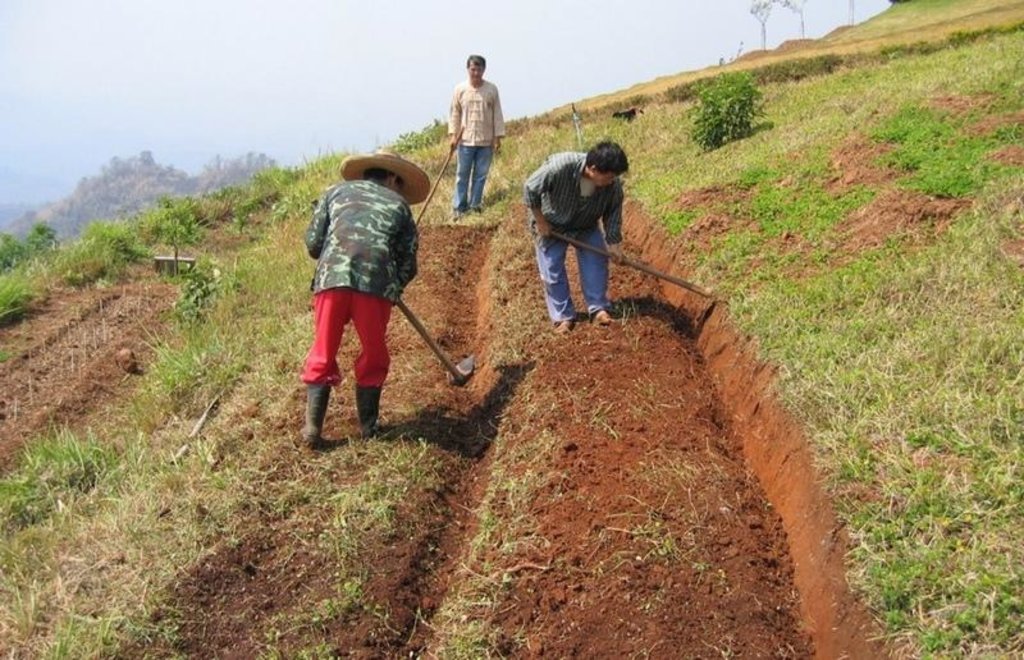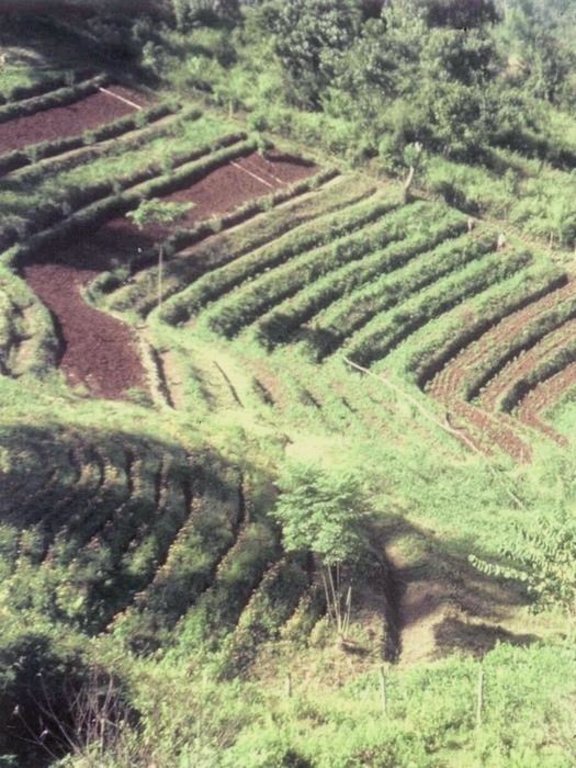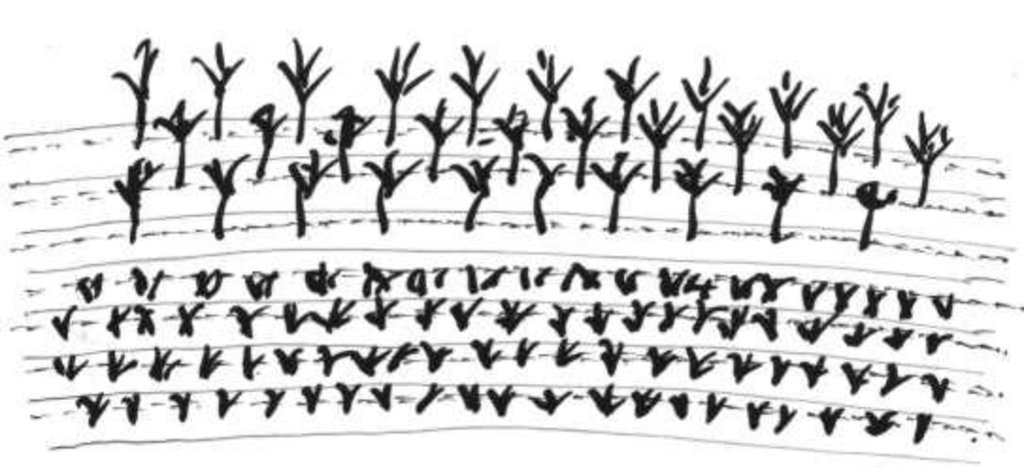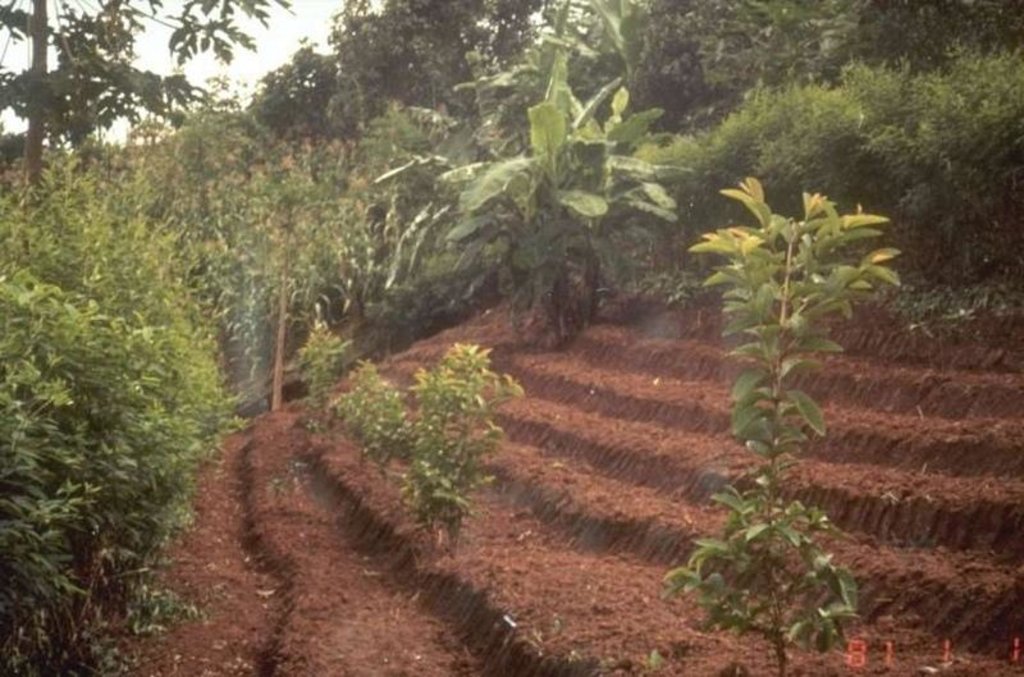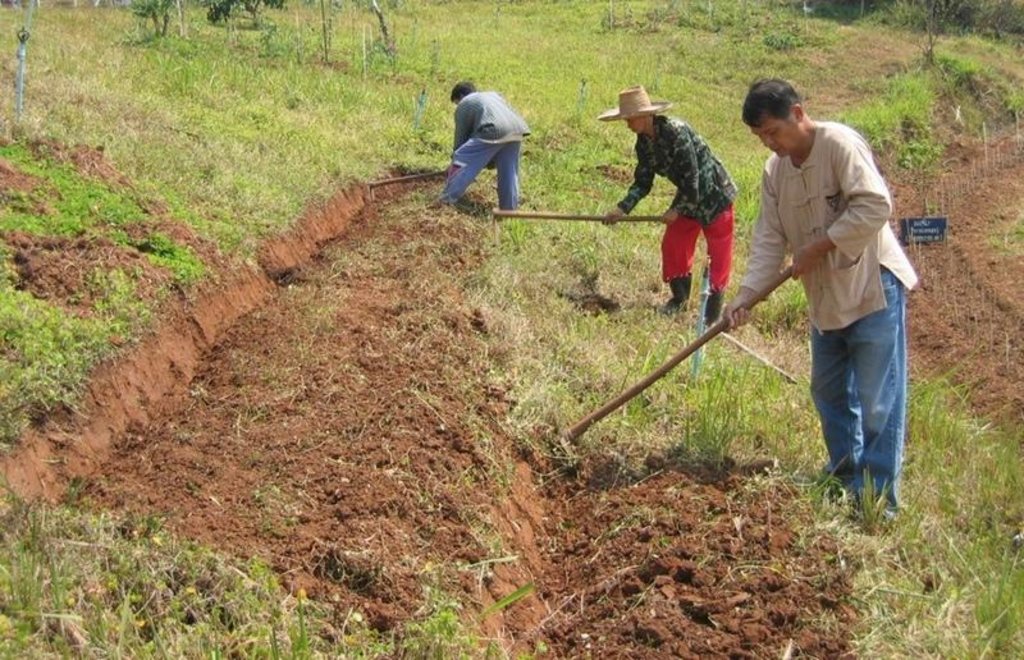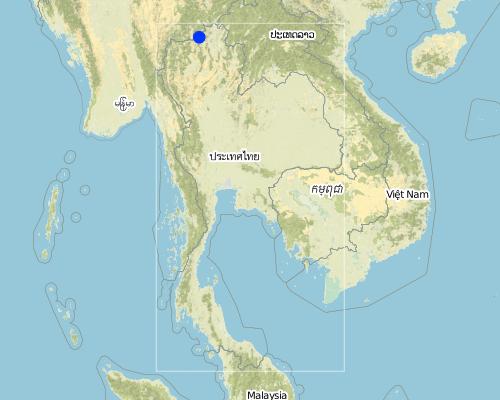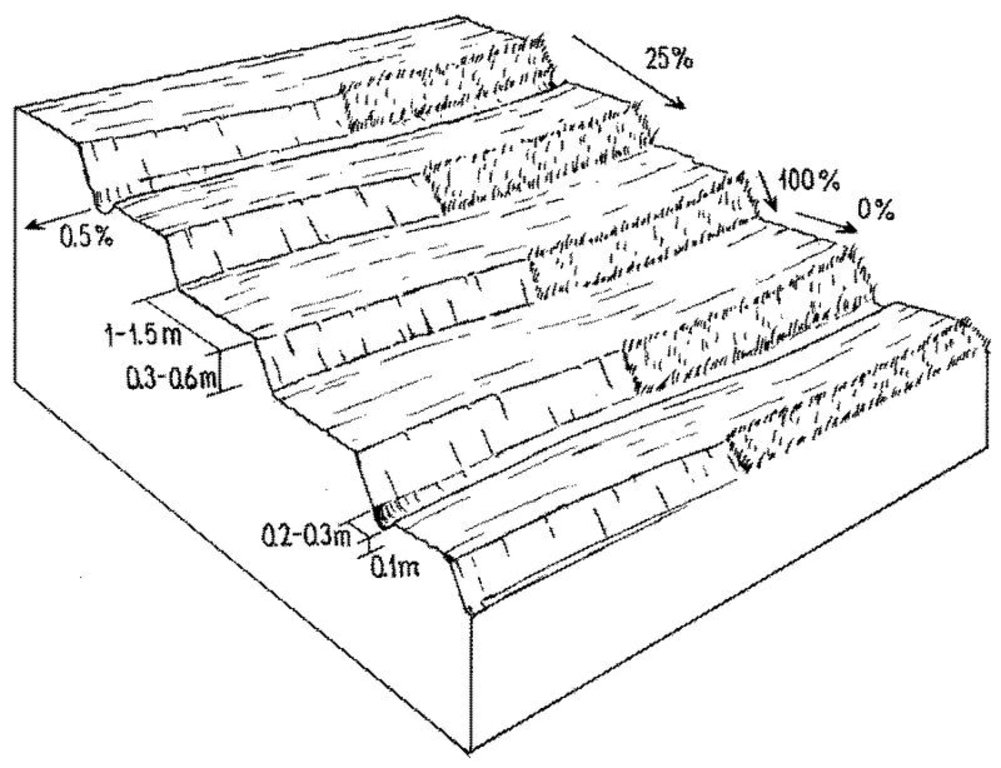Small level bench terraces [Tailândia]
- Criação:
- Atualização:
- Compilador/a: Samran Sombatpanit
- Editor: –
- Revisor: Fabian Ottiger
Khan ban dai din khanard lek (Thai)
technologies_1404 - Tailândia
Veja as seções
Expandir tudo Recolher tudo1. Informação geral
1.2 Detalhes do contato das pessoas capacitadas e instituições envolvidas na avaliação e documentação da tecnologia
Especialista em GST:
Cheewinkuntong Wichai
Wang Put Tan, Ban Santikiri, Amphur Mae Fa Luang, Chiang Rai 57110
Tailândia
Nome do projeto que facilitou a documentação/avaliação da Tecnologia (se relevante)
Book project: where the land is greener - Case Studies and Analysis of Soil and Water Conservation Initiatives Worldwide (where the land is greener)Nome da(s) instituição(ões) que facilitou(ram) a documentação/ avaliação da Tecnologia (se relevante)
World Association of Soil and Water Conservation (WASWC) - China1.3 Condições em relação ao uso da informação documentada através de WOCAT
Quando os dados foram compilados (no campo)?
30/05/2000
O/a compilador/a e a(s) pessoa(s) capacitada(s) aceitam as condições relativas ao uso de dados documentados através da WOCAT:
Sim
2. Descrição da tecnologia de GST
2.1 Descrição curta da tecnologia
Definição da tecnologia:
Terraces with narrow beds, used for growing tea, coffee, and horticultural crops on hillsides cleared from forests.
2.2 Descrição detalhada da tecnologia
Descrição:
The terraces described in this case study from northern Thailand are found on hilly slopes with deep soils. The climate is humid and tropical, with 1,700-2,000 mm of rainfall annually. The main aim of the terraces is to facilitate cultivation of tea or coffee on sloping land: erosion control is secondary. Coffee and tea, as well as flowers and vegetables, are good alternatives to opium poppies - which it is government policy to eradicate.
Purpose of the Technology: After clearing natural and secondary forests by slash and burn, terraces are aligned by eye - and constructed by hoe. The width of the bed is 1.0-1.5 m depending on slope, though there are no specific technical guidelines. The length of each terrace can be up to 25 m. Down the slope, after every 3-4 terraces, there are lateral drainage channels, approximately 20-30 cm wide and 10 cm deep. Situated at the foot of a riser, each channel has a gradient of 0.5% or less. Excess water - some of which cascades over the terrace risers, with some draining through the soil - is discharged through these channels, generally to natural waterways. The risers are steep, with a slope of above 100%, and without a defined lip.
Establishment / maintenance activities and inputs: Natural grass cover develops on the risers: this is cut back by hand hoe or machete, or completely removed. The grass is often burned. After harvest (of annual crops), the land is left until immediately before the next rainy season. The terraces at this stage are covered by weeds and grasses. Land is then tilled by hoe. The weeds and grasses are removed and heaped in piles outside the cropped area. They are not composted or used for mulching - and here an opportunity is missed. Where soil fertility is a problem, chemical fertilizers are used. Maintenance includes building up/repairing of risers and levelling of terrace beds as required.
Natural / human environment: The technology was pioneered, and continues to be practiced, by refugee immigrants from China looking for new areas to start farming. These immigrants first came in the 1950s, and cultivated simply through slash and burn techniques. During the 1970s they visited relatives in Taiwan and brought back the idea of small terraces. Originally they settled illegally, but eventually they were given official permission to stay. However, official title deeds to their land have not yet been allocated.
2.3 Fotos da tecnologia
2.5 País/região/locais onde a tecnologia foi aplicada e que estão cobertos nesta avaliação
País:
Tailândia
Região/Estado/Província:
ChiangMai
Especificação adicional de localização:
Amphur Mae Fa Luang
Map
×2.6 Data da implementação
Caso o ano exato seja desconhecido, indique a data aproximada:
- menos de 10 anos atrás (recentemente)
2.7 Introdução da tecnologia
Especifique como a tecnologia foi introduzida:
- atráves de inovação dos usuários da terra
Comentários (tipos de projeto, etc.):
Taiwan.
3. Classificação da tecnologia de GST
3.1 Principal/principais finalidade(s) da tecnologia
- Melhora a produção
- Reduz, previne, recupera a degradação do solo
- Criar impacto econômico benéfico
3.2 Tipo(s) atualizado(s) de uso da terra onde a tecnologia foi aplicada

Terra de cultivo
- Cultura anual
- Cultura perene (não lenhosa)
Principais plantações (colheitas para venda e consumo próprio):
Major cash crop annual cropping: Tee, coffee
Major cash crop perennial (non-woody) cropping: Vegetables, flowers
Comentários:
Major land use problems (compiler’s opinion): - soil erosion on cultivated hillsides
- practical difficulties in tending tea, coffee, vegetables and flowers on sloping land: farming is much easier on levelled land
- Lacking of land ownership (The whole area is reserved forest.)
- Low price of agricultural produce.
Major land use problems (land users’ perception): 1. Lacking of land ownership. 2. Landusers do not have Thai citizenship; less than 20% have ID cards (not citizenship).
Forest: before SWC measures
3.3 Mais informações sobre o uso da terra
Abastecimento de água para a terra na qual a tecnologia é aplicada:
- Precipitação natural
Número de estações de cultivo por ano:
- 2
Especifique:
Longest growing period in days: 150 Longest growing period from month to month: Dec - Apr
3.4 Grupo de GST ao qual pertence a tecnologia
- Medidas de curva de nível
- Desvio e drenagem de água
3.5 Difusão da tecnologia
Especifique a difusão da tecnologia:
- Uniformemente difundida numa área
Caso a tecnologia seja uniformemente difundida numa área, indique a área coberta aproximada:
- 1-10 km2
Comentários:
Total area covered by the SLM Technology is 5 km2.
This practice has been done by tribal people such as E-kaw, Lahu, Lisu, Mien, Khin, Thai Yai, Haw Chinese, H'mong
3.6 Medidas de GST contendo a tecnologia

Medidas vegetativas
- V2: gramíneas e plantas herbáceas perenes

Medidas estruturais
- S1: Terraços
Comentários:
Main measures: structural measures
Secondary measures: vegetative measures
3.7 Principais tipos de degradação da terra abordados pela tecnologia

Erosão do solo pela água
- Wt: Perda do solo superficial/erosão de superfície

Deteriorização química do solo
- Cn: declínio de fertilidade e teor reduzido de matéria orgânica (não causado pela erosão)

Degradação da água
- Ha: aridificação
Comentários:
Main type of degradation addressed: Wt: loss of topsoil / surface erosion, Cn: fertility decline and reduced organic matter content, Ha: aridification
Main causes of degradation: deforestation / removal of natural vegetation (incl. forest fires), Lack of enforcement of legislation or authority
Secondary causes of degradation: other human induced causes (specify) (Agricultural activities), other natural causes (avalanches, volcanic eruptions, mud flows, highly susceptible natural resources, extreme topography, etc.) specify
3.8 Redução, prevenção ou recuperação da degradação do solo
Especifique o objetivo da tecnologia em relação a degradação da terra:
- Prevenir degradação do solo
4. Especificações técnicas, implementação de atividades, entradas e custos
4.1 Desenho técnico da tecnologia
4.2 Especificações técnicas/ explicações do desenho técnico
Layout of small level bench terraces. After every third or fourth terrace a lateral drainage channel is built. Later, protective grass cover is established on the risers (right).
Technical knowledge required for field staff / advisors: moderate
Technical knowledge required for land users: moderate
Main technical functions: control of dispersed runoff: retain / trap, reduction of slope angle, reduction of slope length
Secondary technical functions: control of concentrated runoff: impede / retard, increase of infiltration, increase / maintain water stored in soil
Vegetative measure: grass on risers (optional)
Vegetative material: G : grass
Vegetative measure: Vegetative material: G : grass
Vegetative measure: Vegetative material: G : grass
Vegetative measure: Vegetative material: G : grass
Terrace: bench level
Vertical interval between structures (m): 0.4
Spacing between structures (m): 0.3
Height of bunds/banks/others (m): 0.4
Width of bunds/banks/others (m): 1.5
Length of bunds/banks/others (m): 25
Structural measure: drainage channels
Depth of ditches/pits/dams (m): 0.1
Width of ditches/pits/dams (m): .02 - .3
Construction material (earth): It is the earth dug in situ.
Lateral gradient along the structure: 0%
Vegetation is used for stabilisation of structures.
4.3 Informação geral em relação ao cálculo de entradas e custos
Outro/moeda nacional (especifique):
Baht
Indique a taxa cambial do dólar norte americano para a moeda local (se relevante): 1 USD =:
37,0
Indique a média salarial da mão-de-obra contratada por dia:
2.16
4.4 Atividades de implantação
| Atividade | Tipo de medida | Periodicidade | |
|---|---|---|---|
| 1. | Layout is simply by eye and best judgment. | Estrutural | |
| 2. | Work begins on the lower part of the slope, and then progresses uphill. | Estrutural | |
| 3. | Farmers cut into the hillside with hoes and drag the soil down to formthe risers and level the terrace beds. | Estrutural | |
| 4. | Risers are then stabilised/compacted by hoe. | Estrutural |
4.5 Custos e entradas necessárias para a implantação
| Especifique a entrada | Unidade | Quantidade | Custos por unidade | Custos totais por entrada | % dos custos arcados pelos usuários da terra | |
|---|---|---|---|---|---|---|
| Mão-de-obra | Labour | ha | 1,0 | 270,0 | 270,0 | 100,0 |
| Equipamento | Tools | ha | 1,0 | 5,0 | 5,0 | 100,0 |
| Custos totais para a implantação da tecnologia | 275,0 | |||||
Comentários:
Duration of establishment phase: 12 month(s)
4.6 Atividades recorrentes/manutenção
| Atividade | Tipo de medida | Periodicidade/frequência | |
|---|---|---|---|
| 1. | Weeds and grasses are removed and piled outside the cropping area. | Vegetativo | |
| 2. | Land is prepared through tillage by hoe. | Estrutural | |
| 3. | Risers are built up/repaired where necessary. | Estrutural | |
| 4. | Terrace beds may need levelling. | Estrutural |
4.7 Custos e entradas necessárias pata a manutenção/atividades recorrentes (por ano)
| Especifique a entrada | Unidade | Quantidade | Custos por unidade | Custos totais por entrada | % dos custos arcados pelos usuários da terra | |
|---|---|---|---|---|---|---|
| Mão-de-obra | Labour | ha | 1,0 | 45,0 | 45,0 | 100,0 |
| Equipamento | Tools | ha | 1,0 | 45,0 | 45,0 | 100,0 |
| Custos totais para a manutenção da tecnologia | 90,0 | |||||
Comentários:
Clearing of forest is not included in the cost calculations. This calculation is based on a typical slope of approximately 20%, with risers of 0.2 m in height and beds 1.0 m wide. Maintenance costs include basic land preparation (for annual crops) or weeding etc for perennial crops.
4.8 Fatores mais importantes que afetam os custos
Descreva os fatores mais determinantes que afetam os custos:
The slope factor affects most because it will require longer time to construct.
5. Ambiente natural e humano
5.1 Clima
Precipitação pluviométrica anual
- <250 mm
- 251-500 mm
- 501-750 mm
- 751-1.000 mm
- 1.001-1.500 mm
- 1.501-2.000 mm
- 2.001-3.000 mm
- 3.001-4.000 mm
- > 4.000 mm
Especificações/comentários sobre a pluviosidade:
Average 1600-1800 mm
Zona agroclimática
- úmido
Thermal climate class: tropics
5.2 Topografia
Declividade média:
- Plano (0-2%)
- Suave ondulado (3-5%)
- Ondulado (6-10%)
- Moderadamente ondulado (11-15%)
- Forte ondulado (16-30%)
- Montanhoso (31-60%)
- Escarpado (>60%)
Formas de relevo:
- Planalto/planície
- Cumes
- Encosta de serra
- Encosta de morro
- Sopés
- Fundos de vale
Zona de altitude:
- 0-100 m s.n.m.
- 101-500 m s.n.m.
- 501-1.000 m s.n.m.
- 1.001-1.500 m s.n.m.
- 1.501-2.000 m s.n.m.
- 2.001-2.500 m s.n.m.
- 2.501-3.000 m s.n.m.
- 3.001-4.000 m s.n.m.
- > 4.000 m s.n.m.
Comentários e outras especificações sobre a topografia:
Slopes on average: Also steep (ranked 3)
Soil fertility: Low (ranked 1) and very low (ranked 2)
Soil drainage/infiltration: Medium (ranked 1, good drainage though being cleyey soil) and good (ranked 2)
Soil water storage capacity: Medium and low (both ranked 1)
5.3 Solos
Profundidade do solo em média:
- Muito raso (0-20 cm)
- Raso (21-50 cm)
- Moderadamente profundo (51-80 cm)
- Profundo (81-120 cm)
- Muito profundo (>120 cm)
Textura do solo (solo superficial):
- Médio (limoso, siltoso)
Matéria orgânica do solo superficial:
- Baixo (<1%)
5.6 Características dos usuários da terra que utilizam a tecnologia
Orientação de mercado do sistema de produção:
- Subsistência (autoabastecimento)
- Comercial/mercado
Rendimento não agrícola:
- 10-50% de toda renda
Nível relativo de riqueza:
- Pobre
- Média
Nível de mecanização:
- Trabalho manual
- Tração animal
Indique outras características relevantes dos usuários da terra:
Population density: < 10 persons/km2
6% of the land users are rich and own 35% of the land.
24% of the land users are average wealthy and own 40% of the land.
60% of the land users are poor and own 20% of the land.
10% of the land users are poor and own 5% of the land.
Off-farm income specification: farmers spend much time as farm labourers on other farms or in food processing factories - and some have jobs at construction sites, for example road building
Level of mechanization: Manual work (ranked 1) and animal traction (ranked 2)
Market orientation: Commercial/market (ranked 1, tea, coffee, vegetable and flower production) and subsistence (ranked 2)
5.7 Média da área de terra própria ou arrendada por usuários da terra que utilizam a tecnologia
- < 0,5 ha
- 0,5-1 ha
- 1-2 ha
- 2-5 ha
- 5-15 ha
- 15-50 ha
- 50-100 ha
- 100-500 ha
- 500-1.000 ha
- 1.000-10.000 ha
- > 10.000 ha
Comentários:
Average area of land owned or leased by land users applying the Technology: Also 2-5 ha if farmers may farm at 2-4 plots far apart from each other.
5.8 Propriedade de terra, direitos de uso da terra e de uso da água
Propriedade da terra:
- Estado
Direitos do uso da terra:
- Indivíduo
- illegal (initially) (see Annex T3)
- illegal (initially) (see Annex T3)
6. Impactos e declarações finais
6.1 Impactos no local mostrados pela tecnologia
Impactos socioeconômicos
Produção
Produção agrícola
Comentários/especificar:
Production is not decreased.
Área de produção
Gestão de terra
Renda e custos
Rendimento agrícola
Disparidades econômicas
Carga de trabalho
Comentários/especificar:
Ease of cultivation. Can walk and work in the farm easier
Outros impactos socioeconômicos
Input constraints
Impactos socioculturais
Instituições comunitárias
Instituições nacionais
Atenuação de conflitos
Impactos ecológicos
Ciclo hídrico/escoamento
Escoamento superficial
Quantidade anterior à GST:
20
Quantidade posterior à GST:
15
Solo
Umidade do solo
Comentários/especificar:
During dry spells due to increased infiltration
Cobertura do solo
Perda de solo
Quantidade anterior à GST:
50
Quantidade posterior à GST:
10
Comentários/especificar:
Soil erosion is reduced
Ciclo e recarga de nutrientes
Biodiversidade: vegetação, animais
Diversidade vegetal
Diversidade animal
Diversidade de habitat
6.2 Impactos externos mostrados pela tecnologia
Caudal confiável e estável em período seco
Cheias de jusante
Sedimentação a jusante
Poluição de água subterrânea/rio
Sedimentos transportados pelo vento
6.4 Análise do custo-benefício
Como os benefícios se comparam aos custos de implantação (do ponto de vista dos usuários da terra)?
Retornos a curto prazo:
levemente positivo
Retornos a longo prazo:
positivo
Como os benefícios se comparam aos custos recorrentes/de manutenção(do ponto de vista dos usuários da terra)?
Retornos a curto prazo:
levemente positivo
Retornos a longo prazo:
positivo
6.5 Adoção da tecnologia
Se disponível, determine a quantidade (número de unidades familiares e/ou área abordada):
500
Entre todos aqueles que adotaram a tecnologia, quantos adotaram espontaneamente, ou seja, sem receber nenhum incentivo material/pagamentos?
- 50-90%
Comentários:
10% of land user families have adopted the Technology with external material support
50 land user families have adopted the Technology with external material support
Comments on acceptance with external material support: estimates
90% of land user families have adopted the Technology without any external material support
450 land user families have adopted the Technology without any external material support
Comments on spontaneous adoption: estimates
There is a little trend towards spontaneous adoption of the Technology
Comments on adoption trend: There is a little growing spontaneous adoption: for example in the Mae Salong area farmers accept these terraces increasingly, but fruit growers tend to prefer intermittent ‘orchard terraces’ - terraces spaced apart, with 5 m or more of undisturbed land in-between. The benches in this case are backward sloping.
6.7 Pontos fortes/vantagens/oportunidades da tecnologia
| Pontos fortes/vantagens/oportunidades na visão do usuário da terra |
|---|
| For facilitating picking of tea leaves |
| For using as farm path |
| For increasing soil fertility |
| Pontos fortes/vantagens/oportunidades na visão do/a compilador/a ou de outra pessoa capacitada |
|---|
|
A relatively cheap method of terracing which makes cultivation easier and provides erosion control How can they be sustained / enhanced? Should be further promoted by extension agencies (in areas where cultivation is officially allowed). Allocation of official title deeds to land will speed up the adoption automatically. |
| For improving/maintaining soil fertility |
|
For increasing the yield of tea leaves How can they be sustained / enhanced? Inspecting the field during/after rain to see how efficient they are in conserving soil and water and repair as needed |
| For using as farm path |
| Compared with normal bench terraces, construction does not bring infertile subsoil to the surface. |
6.8 Pontos fracos, desvantagens/riscos da tecnologia e formas de superá-los
| Pontos fracos/desvantagens/riscos na visão do usuário da terra | Como eles podem ser superados? |
|---|---|
| Farmers have to pay for its construction. | The government may be able to help in the future. |
| Pontos fracos/vantagens/riscos na visão do/a compilador/a ou de outra pessoa capacitada | Como eles podem ser superados? |
|---|---|
| Does not lend itself to mechanisation: the terrace beds are narrow and only suited to hand hoeing. | Teach farmers techniques of composting and/or mulching. |
|
In this situation grasses and weeds are merely piled and burned rather than being used to improve soil fertility |
7. Referências e links
7.2 Referências às publicações disponíveis
Título, autor, ano, ISBN:
No references
Links e módulos
Expandir tudo Recolher tudoLinks
Não há links
Módulos
Não há módulos


